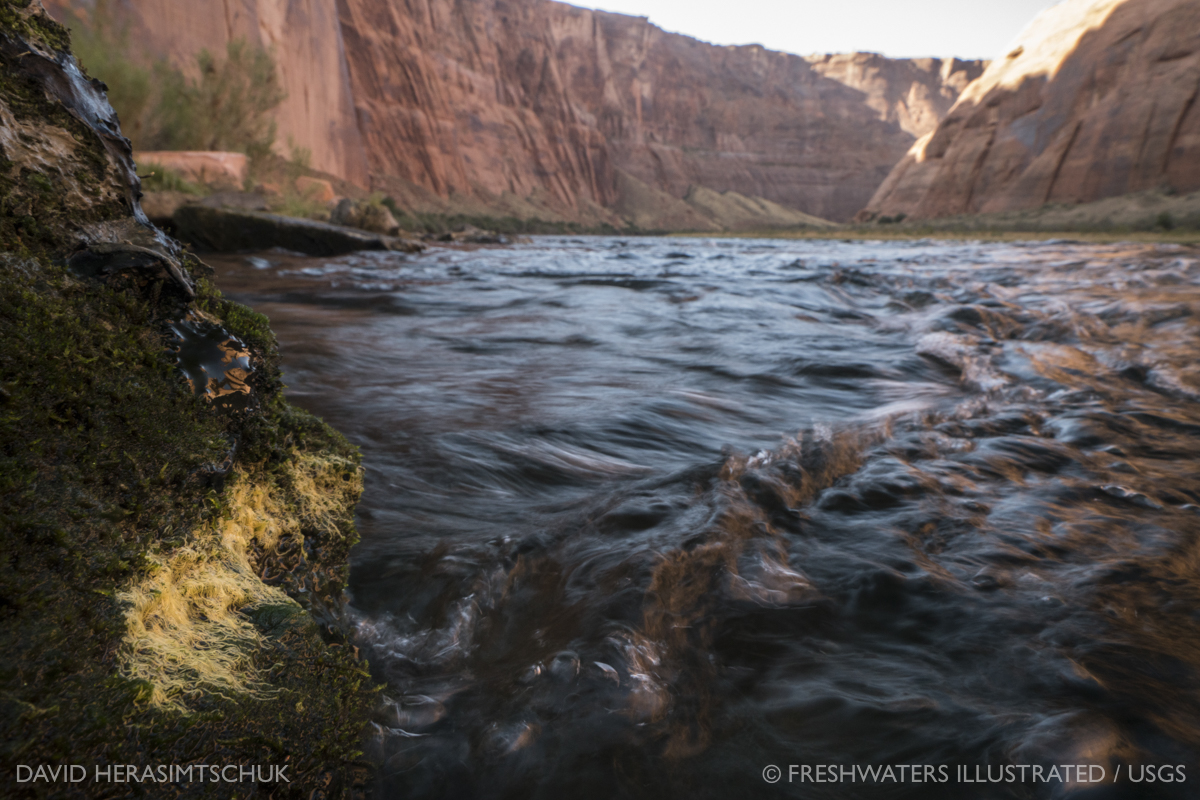 Freshwaters Illustrated photo of aquatic insect eggs on a rock during a bug flow experiment
Freshwaters Illustrated photo of aquatic insect eggs on a rock during a bug flow experiment
SALT LAKE CITY—The Bureau of Reclamation announced today a Macroinvertebrate Production Flow, or Bug Flow, will be conducted this summer at Glen Canyon Dam under the Long-Term Experimental and Management Plan. This experiment is designed to improve egg-laying conditions for aquatic insects that are the primary food source for fish in the Colorado River. The experiment will begin May 1 and continue through August 31, 2022.
The decision to conduct this experiment was based on input from a collaborative team, including the Department of the Interior’s Bureau of Reclamation, U.S. Geological Survey, National Park Service, U.S. Fish and Wildlife Service and Bureau of Indian Affairs. Flow experiments are designed to optimize benefits to the Lees Ferry Reach and Grand Canyon’s Colorado River ecosystem while meeting water delivery requirements and minimizing negative impacts to hydropower production.
“We are pleased to continue our research on the effects of modifying release flow patterns to benefit the Colorado River ecosystem,” said Michael Moran, Acting Chief of the U.S. Geological Survey Grand Canyon Monitoring and Research Center, which monitors Colorado River ecosystem response to all Glen Canyon Dam flow experiments. “Past research has shown that many different resources have benefitted from previous experimental flows, and we are looking forward to collecting this additional data on the river.”
Bug Flows are a water flow experiment that consists of steady, low weekend releases from Glen Canyon Dam and normal fluctuating releases for hydropower during weekdays. Bug Flows do not affect total annual, monthly or weekly release volumes from Lake Powell through Glen Canyon Dam, but slightly modify release schedules and flow rates. Recreational river users will likely notice steady flows resulting from the steady weekend releases as they move downstream through the Lees Ferry Reach and the Grand Canyon. Dam releases and minimum flows are within the range typically experienced by recreation users (e.g., anglers, boaters, kayakers and campers).
“In this time of unprecedented drought, continuing experiments like Bug Flows in compliance with the Grand Canyon Protection Act are critical,” said Reclamation’s Upper Colorado Basin Regional Director Wayne Pullan. “At the same time, drought makes assessing and mitigating for the effects of those experiments on other resources like hydropower, water supply and recreation increasingly important.”
The purpose of these experimental flows is to identify whether this type of operation can improve the abundance, diversity and stability of aquatic insect populations, thereby increasing aquatic insect prey available for a variety of wildlife. Insects expected to benefit from this experiment are an important food source for many species of fish, birds, and bats in the canyon.
Bug Flow experiments were implemented at Glen Canyon Dam from May through August for three consecutive years: 2018, 2019 and 2020, but were not implemented in 2021. Findings suggest that the previous Bug Flow experiments may have improved conditions for adult insects, increased the abundance of caddisflies river wide, and increased algae production. In addition, anglers captured more rainbow trout on average during Bug Flows than they did during typical fluctuating flow patterns. Contrary to predictions, no increase in the abundance of midge flies were observed during the first three years of the experiment. Scientists believe that further experimentation, research and monitoring may help to determine whether the Bug Flows experiment benefits native fishes in the Lees Ferry Reach below the Glen Canyon Dam and in the Grand Canyon. This experiment provides scientific information important to future decision-making.
The Glen Canyon Dam Implementation Team will closely monitor the condition of resources during the experiment and may terminate implementation at any time if unanticipated negative impacts are observed or are likely to occur due to ongoing drought and low lake levels.


